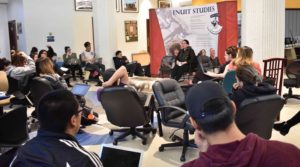School helps Inuit students meet the urban challenge
Linda Scales

Photo: Nunavut Sivuniksavut
The students at Nunavut Sivuniksavut—perhaps Sandy Hill’s smallest post-secondary school—are typical of many other students counting the days and weeks until classes end. However, at NS (as it’s commonly called), there is a particular reason.
“By the end of April and early May, our students get spring fever,” says NS coordinator Morley Hanson about the 60-some Inuit aged 18 to 25 years from northern communities such as Pond Inlet, Iqaluit and Grise Fiord. “This time of year at home is precious and wonderful because the sun is high and warm. There’s still lots of snow so they can do outdoor things. By then, Ottawa becomes a nice place to visit, but they don’t want to live here anymore.”
Nunavut Sivuniksavut (Inuktitut for “a place and time to become wise”) might also be one of Sandy Hill’s most unique schools because it is dedicated to providing Inuit youth with a cultural and educational experience unlike any to be found in Nunavut.
Located in the Place de la Francophonie building at the southeast corner of Rideau and Chapel Streets since 2011, NS provides a post-secondary education in Inuit Studies. When it was founded in 1985, the institution’s purpose, tied to the eastern Arctic land claims negotiations with the federal government, was to train Inuit fieldworkers so they could inform their communities about the progress of the negotiations. Over time, the program evolved to meet the needs of younger Inuit.
Affiliated with Algonquin College through a unique arrangement that allows its independence, NS offers three separate fully accredited programs beginning in September of each year.
A Leap of Faith
“The students don’t come here for the certificates,” says Hanson. “They come because their peers, family, friends and teachers have said that NS is the next thing to do best.” The application process is competitive with double the number of applicants vying for 42 available spots in the Inuit Studies program, the school’s core program. The Advanced Inuit Studies program accepts less than half that number from the graduates of the core program, while a new pilot program combines federal government work terms with semesters of university courses. Its future has yet to be decided.
Coming to Ottawa requires “a leap of faith to jump on a plane and come down here for a year of study,” says Hanson about the cultural transition that for many NS students is their first experience away from their families and communities. Acclimatizing to urban life is challenging for them, he says. “It’s the constant invasion of stimulation. The language, the food, the independence, making all of their decisions on their own. It’s a stressful, high-intensity program, but that’s when you do your best learning.”
Despite the extreme cultural shift, the school’s retention rate is between 80% and 85%. This is partly due to the personal support NS gives every student, such as tutoring, childcare if needed, and housing in one of three “almost brand-new” apartment buildings, also in Sandy Hill. “The location is superb, and we have safer, more secure quality accommodations than we’ve ever had before,” says Hanson.
Coursework includes classes in Inuit history, Inuit cultural studies, public administration, community development, contemporary Inuit issues, details of the Nunavut Land Claims Agreement and the circumpolar world. Moreover, the students proudly demonstrate their culture to the Ottawa community through traditional throat singing, Arctic sports, and clothing displays at activities like Winterlude and by visiting local schools. They also use their talents to fundraise for the school’s annual end-of-the-year trip. This year, three small groups of students will visit Hawaii, Peru, or Finland and Norway, where they will share their culture and Nunavut’s story with the Indigenous people of those countries.
The majority of NS graduates choose to return to Nunavut after their experience in Ottawa, where they might continue their education at Nunavut Arctic College or find work. However, a small percentage choose to return to southern Canada for further post-secondary education.
“They’ve got a lot of new knowledge they never had before,” Hanson says. “The biggest benefit of all is they have a lot more pride in who they are, and have a lot more confidence, enthusiasm and passion for making their contribution.”

Photo: Nunavut Sivuniksavut
